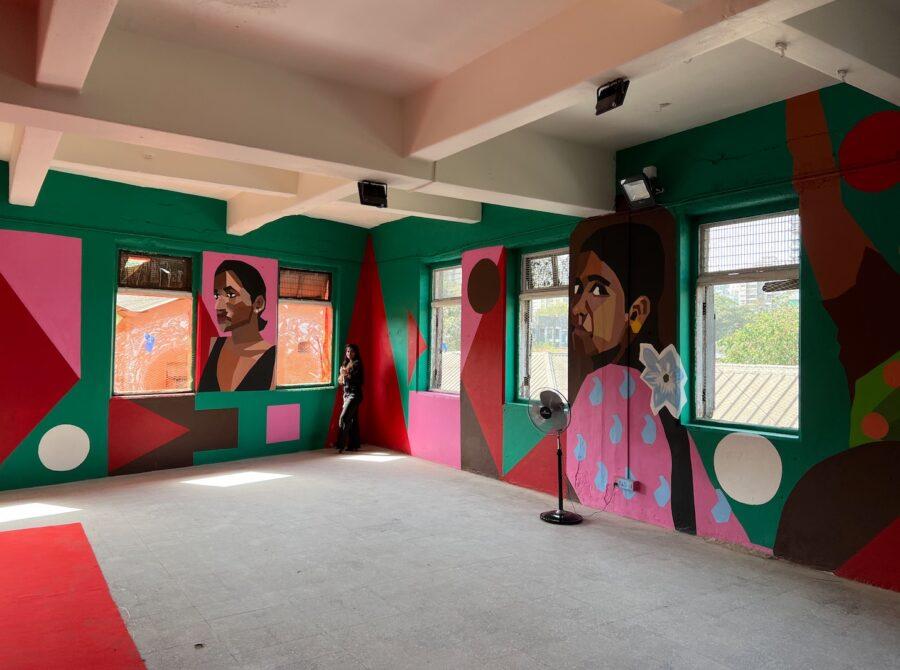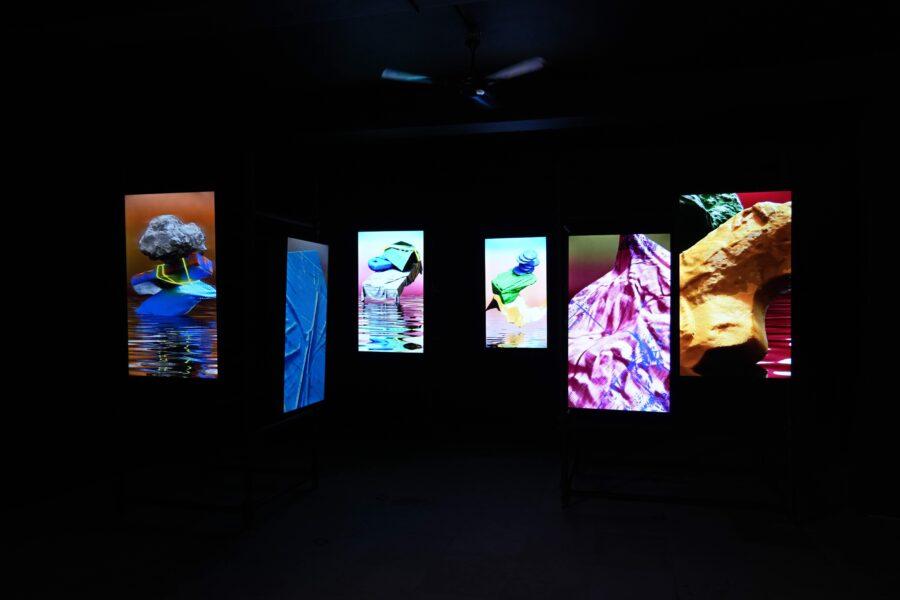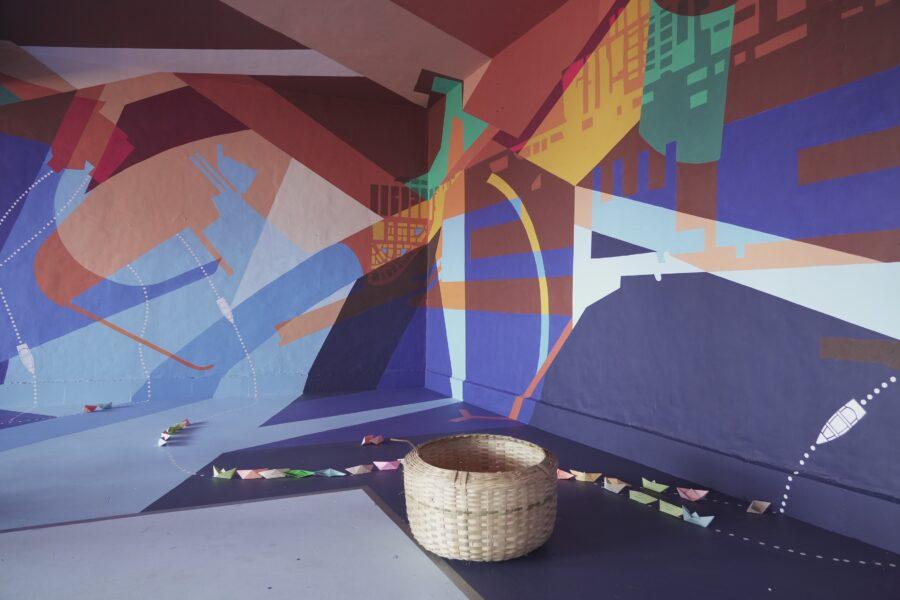As the city takes selfies against vibrant art, it also captures stories of the land and sea
 Photography by TARQ, Sohil Belim featuring Parag Tandel, Vitamin Sea, 2014-2022
Photography by TARQ, Sohil Belim featuring Parag Tandel, Vitamin Sea, 2014-2022
Words by Aastha D.
Mumbai, a city that knows no respite from movement, permits little time to be moved. Its frenzied streets are a landscape of labouring bodies; selling, buying, yelling, driving, singing, honking, walking, sprinting, falling, standing, pushing, sweating, always moving. Bodies against and alongside each other, a frictional synchrony that sparks a collective fury for survival, day after day.
It is on these streets of unrelenting movement that an hiatus occurs, allowing for Mumbai to be moved by art, words, colours, and stories. The Mumbai Urban Arts Festival at the Sassoon docks (oldest docks at 142 years) comes as an extension to the 150th anniversary of the Mumbai Port Authority and unpacks the theme ‘Between the Sea and the City’.
St+art India foundation and Asian Paints take the festival to multiple locations across the city, especially in SoBo (South Bombay). These include The AP Art House in Colaba, the famous Sassoon Docks, Mahim East Art District, and Carter Road in Bandra. Weekly schedules of lectures, workshops, panels, film screenings, and performances are posted on Sta+rt India’s Instagram page.
 Photography by Sohil Belim featuring Rero Institut Francais, Alliance Francais
Photography by Sohil Belim featuring Rero Institut Francais, Alliance Francais
Bombay, a floating city on the Arabian Sea, was created by fusing seven islands through multiple land reclamation projects starting 14th century. It exchanged several powerful hands; from being royal dowry a few times, to being leased from one colony to another, temporarily at first and then to conquer and occupy; serving as a major trading port, to being the Naval command of Western India, the city of 20 million, home to the Indian Film Industry or Bollywood, continues its agile legacy.
Contemporary artist, artistic director of St+art India foundation, Hanif Kureshi, said to The Hindu, ‘we want to reclaim the streets to create art for all. Everyone should be able to enjoy art in their everyday life. Which is why many artists, in fact anyone who feels like expressing themselves through art have joined us in painting the walls and streets of Mumbai.’
Artist Steve Messam (from the UK) enveloped the Asian Paints Art House (venue 3/3) with an inflatable sculpture of large spikes that spread out parallel to the ground, attempting to look like a threat yet welcoming invasion. Perhaps a commentary on air as an insidious weapon, reminding us to mask up? An archway marks the entrance to the Sassoon Docks, crossing which you are pummelled by the strong whiff of fish. The whiff becomes an odour that will stay throughout your experience, mask or no mask.

 Photography by Pranav Gohil featuring Symposium for expanded painting, Ad Minoliti in collaboration with Aravani Art Project
Photography by Pranav Gohil featuring Symposium for expanded painting, Ad Minoliti in collaboration with Aravani Art Project

For relief, purple signs that say “smell” indicate that the venue you are about to enter will temporarily alleviate the olfactory. Ayaz Basrai (of Busride Studio) poses curious questions to what we call a home; what if your furniture made you fitter? What if our furniture served as a catalyst for ideas? What if we could reorganise our homes into an interior and an exterior? “A Tiny Home” is a compaction of rooms, made of compressed fibrewood panels put together such that they come apart, the modularity allowing for an interactive experience. As the viewer-dwellers moved around the cube, pulling and rotating parts of it, they inadvertently respond to Ayaz’s provocation-queries.
Plastic, its all-perviousness on land, in the ocean, and the lives that live thrive on both, is a recurring motif. To shock, disgust, and distress into action is no longer the role of plastic in art. At the MUAF, plastic appears alongside fish, turtles, boats, nets, sea beds, shores, in the lives of fisherfolk (the indigenous koli community of Mumbai) who feed the city, while existing alongside its debris and discard.
It is depicted in the traditional Warli form by the indigenous artists, the Vayeda Brothers. Their large mural entitled “Ways of Water”, is one of profound detail, enrapturing with its symbolism, aquatic life, a glum beauty in its frail lines. Then there is “Sea Never Dries” by Serge Attukwei Clottey from Ghana, made of yellow plastic gallon cans, first used to store cooking oil, then to carry water, and ultimately to choke the ocean. This is a part of the artist’s 17 year on-going body of work called “Afrogallonism”, through which he explores environmental protection and social justice.
 Photography by Sohil Belimfeaturing Khyati Trehan, Textured Tourist
Photography by Sohil Belimfeaturing Khyati Trehan, Textured Tourist
On Baraf-Khana or Ice Factory (venue 2/3), Paola Delphin from Mexico painted the black-and-white mural “Humanity” featuring the faces of fisherwomen. The faces seem to steadily reject emotion, as their eyes and wrinkles betray. Diving deep into the myths of his community (the kolis), is Parag Tandel. His work revisits underwater creatures in “Vitamin Sea”; sculptures set in a dark room made of full cast resin, glass reinforced matt, concrete construction rods, rice husk, dirki shells, concrete, Bombay clay, limestone/gypsum, coconut fibre, emanate a dull glow.
On a large wall, lit by clerestories and skylights, is a poem-mural (realised by Tariq Ali and Arif Alam Khan). “Begumpura” borrows its title from a poem by the same name written by Sant Ravidas, an anti-caste poet and reformer of 15th century. Begumpura is an imagined caste-less utopia, one that poet Shripad Sinnakaar imagines further as liberated. Where quenching of thirst, literal and symbolic, is neither a crime, nor a far reaching aspiration.
A place of social mobility, place-making, affirmative action, ambition, and joy. Shripad says, ‘… the untouchable identity is often forced into a homogeneity in its quest for collective assertion, doing a disservice to the vibrancy, nuance and individuality in each individual’s experience, finally reinforcing the upper-caste imagination of Dalits and other oppressed communities as a monolith, erasing identities while thrusting a singular one.’
 Photography by Sohil Belim featuring Aashti Miller, Choropleth
Photography by Sohil Belim featuring Aashti Miller, Choropleth
In conversation with this poem, and perhaps a deliberation on it, is “metromorphosis” by artist Sameer Kulavoor and set-designer Sandeep Meher. ‘What makes a city’ is the question that permeates this work. They construct a sprawling version of a metropolis, its complete and incomplete forms under pressures of real estate speculation.
An almost obsessive attention to detail highlights architecture’s problematic relationship to identity, the installation reveals more the longer you look at it. Playing with scale such that you have to crane your neck to look at the high-rises, that seem to be supported at their base by the underbelly of the city (which is at eye level); shanties, scaffolding, plastic sheets, ornate window grills and door frames from over a century ago. Massive lives living and perishing in tiny spaces.
Sajid Wajid Shaikh in collaboration with Ronak Soni, created this site-specific installation, “Pipes and Leaks” with the same materials that has built Mumbai’s water infrastructure: concrete and pipes. Structured in a way that forces water to run against what would be deemed its normal course, the installation aims to defy gravity, only to see it leak back to its origin. This rather literal rendition seems to encompass commentary on the city and its relationship with the sea; disobedient, cyclical, punitive, and perhaps reparative.
Get a curated collection of design and architecture news in your inbox by signing up to our ICON Weekly newsletter
















